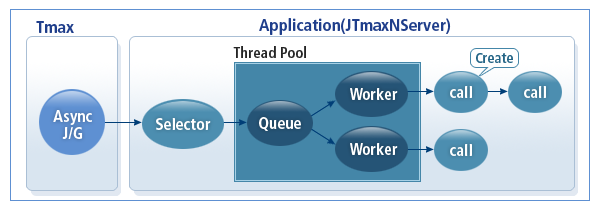Table of Contents
This chapter describes the concepts and features of WebtAsync and the inbound/outbound structure that uses the WebtAsync library.
WebTAsync is a Java library that allows asynchronous communication with the Tmax Async Java gateway. A user or developer can request a service from Tmax, handle a service requested by Tmax, and use libraries to send the Tmax request results back to Tmax. WebTAsync allows bi-directional communication between the Tmax server and another a web application server of another vendor.
WebTAsync is available in versions Tmax 4.0 SP3 Fix#8 and later.
Inbound is a service request sent to JTmaxNServer from Tmax through the Async Java gateway.
A running application (JTmaxNServer), written using the WebTAsync library, waits for a request from the Tmax Async Java gateway. A worker thread handles the service request by calling a callback interface that was previously registered by a user. While JTmax calls ejb, WebTAsync calls a callback interface.
The following shows the Inbound structure.
Outbound is a service request sent to Tmax using the WebTAsync library.
An application written using WebTAsync libraries can establish multiple connections to the Tmax Async Java gateway. While WebT requests a service after getting a connection from the connection pool in an application, WebTAsync internally determines which connection to use and requests it from the service connection pool. This method allows multiple transactions to share the same connection.
A user can handle the next job without waiting for a response. The result is sent to a user by calling callback method, which was previously registered, using a new thread. I.e., if a user registers a callback interface for a result and sends a request, callback method is called using a new thread.
The following shows the Outbound structure.

